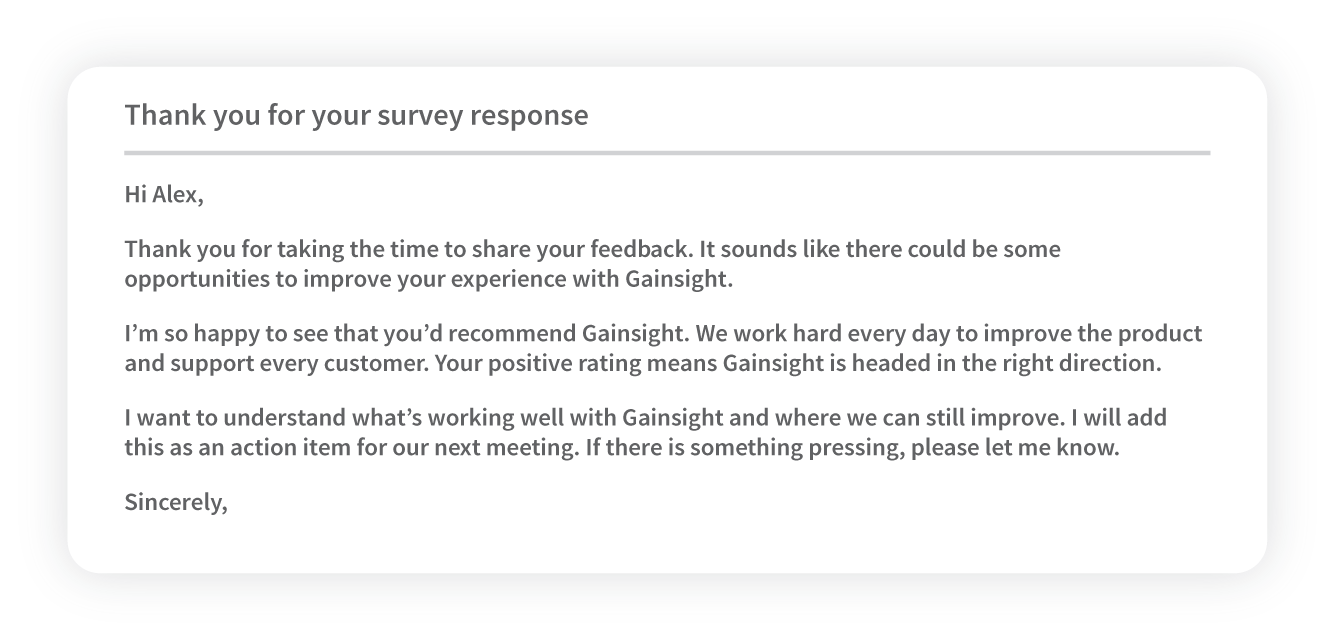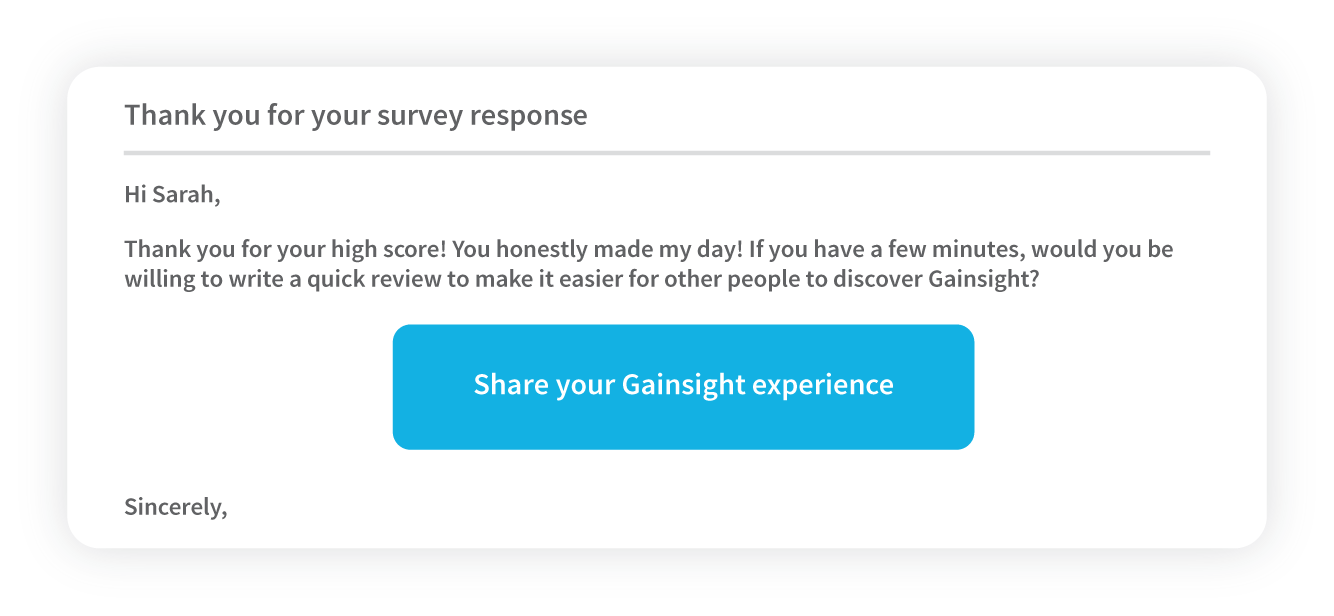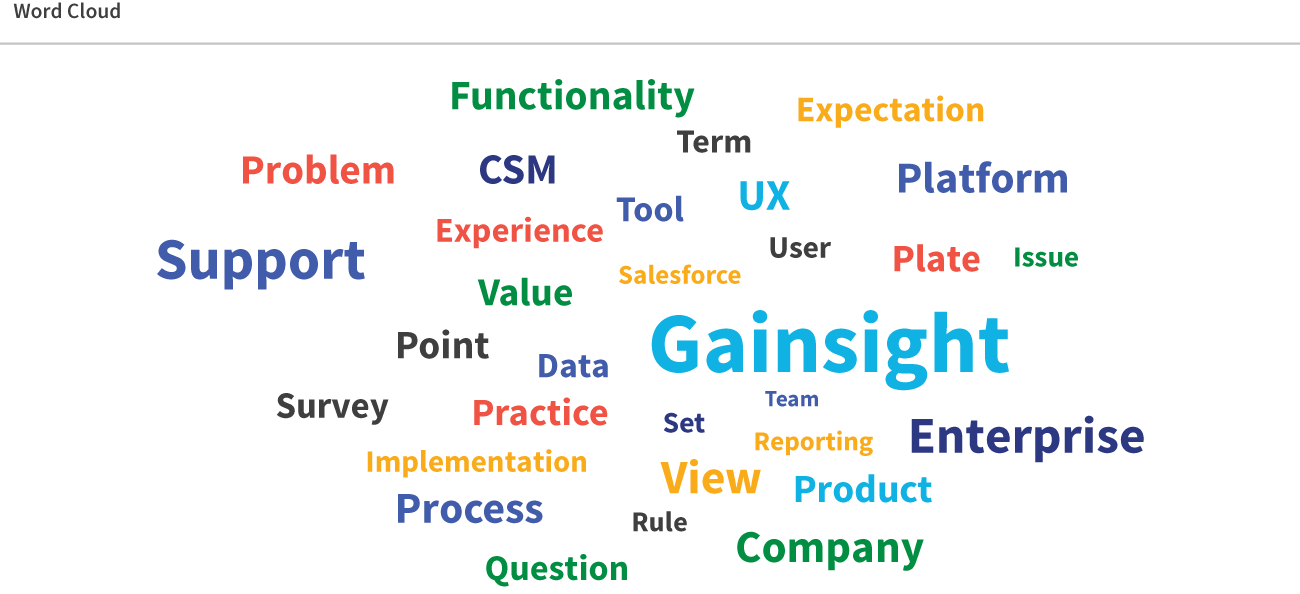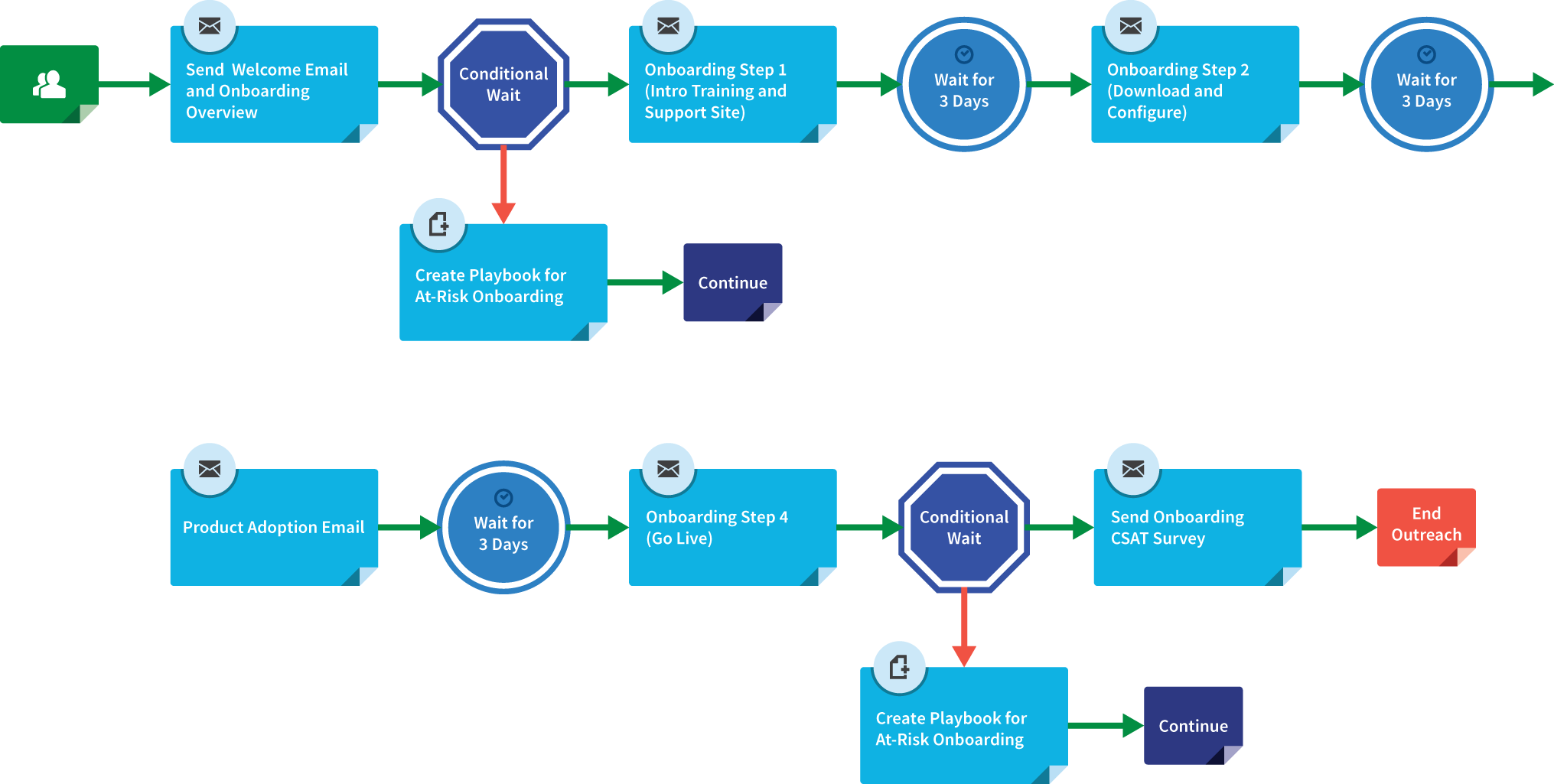10
Voice of the Customer and Your Tech-Touch Strategy
In the previous chapter, we discussed Health Scores as a diagnostic tool to help you manage your customers more effectively by knowing if they are achieving their outcomes and desired experiences. In this chapter, we'll cover how to effectively listen to your customers' feedback and act on it. We'll also talk about your tech-touch strategy, scaling your processes using email automation and in-product engagements, so you can reach more customers without human intervention.
How to Get Meaningful Customer Feedback
A couple of decades ago, Business to Business (B2B) companies were not actively surveying their customers to get their feedback first hand. Over time, surveying methods improved dramatically. You could now argue that companies are guilty of over surveying their customers. Nonetheless, what are they doing with the data? At this point, companies face the challenge of having the data but still not having a consistent and closed-loop approach to improving customer experience. We often observe that not all customers have the right opportunities to offer feedback, or that feedback doesn't get acted on or escalated reliably. When follow-up does occur, we do not have visibility into whether it was effective.
There is a great need to make the process of getting customer feedback and closing the loop with your customers more consistent and predictable. To accomplish this, we recommend a four-step method of identifying and acting on customer experience feedback.
- Listen to the customer: there is only one way to capture the types of data that provide perspectives on the customer's experience, and that is by listening to the customer.
- Capture the voice of the customer: act on customer signals in real-time and be sure all “Voice of the Customer” feedback programs include a closed-loop response and action plan.
- Raise the visibility of progress: analyze the progress against customer experience. This analysis provides visibility to management, teams, and Customer Success Managers.
- Receive input across the organization: improve the customer experience based on input from relevant departments.
Listen to the Customer
The first step in attaining customer feedback is soliciting it and then listening to your customers. As described earlier, a highly recommended listening method would be NPS surveys. The surveys should be sent out every six months to every customer. Decision-makers typically tend to respond better to email surveys while end-users respond better to surveys triggered by your product or in-product because it is more timely and contextual. For Support Customer Satisfaction (CSAT) surveys, they should be sent right after a major interaction or when a support case is completed.
Acknowledge the Feedback
Once you have heard the customer's feedback, it is vital to act on it. For your higher-value customers, it's essential to reach out manually and acknowledge their input. You need to leverage more automation for your smaller customers. If you're responding to a Promoter NPS feedback, send a thank you email with a request for them to participate in your customer reference program. Recall that your Promoters are your most significant source for customer advocates. Another option is an online advocacy program, such as G2 Crowd or TrustRadius. Figure 10.1 is an example of a simple email template to thank Promoters for their survey responses. Figure 10.2 is an example of an email template to request participation in an advocacy program.

Figure 10.1 Example of a closed loop email follow-up for a Promoter NPS Response.

Figure 10.2 Example of a closed loop email follow-up to elicit advocacy.
If you are following up on a Passive NPS response, send a thank you email with a request for a follow-up call to learn more details. If appropriate, you could include links to blog posts or newsletters on product usage as suggestions. Following up on a Detractor NPS response warrants a quick response. First, send a follow-up email recognizing their feedback. Inquire about their answers, respectfully probing for more information. Lastly, request a call or an in-person meeting, if applicable. You may choose to engage the Executive Sponsor at your end, especially for higher-value customers.
Analyze the Information
Now that you've collected feedback and followed up for more details, you have a treasure trove of information. It would help if you used this time to analyze the data and turn it into insights that your company can use to become more customer-centric. Many platforms provide text analytics capability to find common trends and words used in survey responses. You can look for mentions related to product and features, services (e.g. Support, Customer Success), and value delivered (see Figure 10.3). It is also important to see trends over time. Look for improvements or declines after milestone events, such as product releases or user training sessions.

Figure 10.3 Example of word clouds and text analytics based on survey responses.
Implement Results of the Analysis
Finally, use the insights to improve individual functions within your company or increase cross-functional collaboration to become more customer-centric as a company. As a Customer Success Manager, you have the privilege and responsibility of sharing these insights with the company as the voice of your customer. If there is a pattern within customer responses, share it with the departments or teams, and make relevant changes. For example, if a poor user interface is a common reason for low NPS, share the findings with the Product team. If the onboarding process is complicated and a common cause for low NPS, redesign the onboarding process. You can also create case studies to share with the broader company, especially if there is a correlation between NPS and company performance.
The Hidden Value of Customer Feedback
As we began to formulate the different chapters and their topics in this book, we came to the subject of the customer's voice and tech touch. What is intriguing is that tech touch often seems like a voiceless segment due to all the automation and non-personal outreaches. It is actually anything but that. We approached Stephanie Berner, who is the current Global Head of Customer Success at LinkedIn Sales Solutions, to share her views on the issue of getting meaningful feedback from your customers, especially from those who are primarily tech touch. She submitted a simple, yet profound story about “Prospecting for Gold.”
After Stephanie shared these stories with us, we understood why her team was so inspired to look for “golden nuggets” of their own. This is just an illustration of how, as a Customer Success Professional, you can never stop listening to the voice of the customer. You might have to dig a little bit and find the feedback in remote places, but if you do, you have an opportunity to turn it into the real treasure of success.
Tech Touch: The Secrets of Low-Touch Customer Success
Earlier in the book, the subject of “segmentation” was discussed. One segment that was not addressed was that of “low-touch” or “tech-touch” customers. Most companies generally have a “long tail” of smaller customers with low revenue per customer. The term “long tail” was initially used by the former editor of Wired magazine, Chris Anderson. He introduced the business concept both in articles and his 2006 book The Long Tail: Why the Future of Business Is Selling Less of More.1 The long tail concept is that the total volume of less popular goods that are not in high demand can increase profits overall. In the SaaS industry and the field of Customer Success, the “long tail” applies to your smaller customers that when thought of as a combined entity can be a large and profitable business. They might not have the high visibility of enterprise clients, but they also don't have the demands that can eat away profitability. Over time, you will find that tech-touch customers have staying power and the ability to make money in aggregate.
It's hard to serve tech-touch customers economically by staffing Customer Success Managers in this segment. If your business is blessed with high margins even in this segment, the most common themes you are likely to hear include “My Customer Success Managers are overworked” or “Our Customer Success Managers spend a lot of time on repetitive activities” or “We have so many Small-to-Medium Business (SMB) customers that our Customer Success Managers cannot effectively reach out to all of them at a regular cadence.” If any of these sounds familiar, you need a Tech Touch strategy to complement your Customer Success Managers.
It's important to address that having a large segment of tech-touch clients doesn't mean you relinquish the role of the Customer Success Manager. The purpose of the Customer Success Manager is very critical. Tech touch means you are starting with automation and digital engagement to get more scale and involving a human being only when required. When implemented right, your tech-touch strategy aims to automate processes to efficiently manage your long-tail customers across their lifecycle. The idea is to surface risks and expansion opportunities across a large segment of customers with the ultimate goal of prioritizing human intervention only for the most critical situations. In this section, we will discuss the most commonly used use-cases for tech-touch programs.
Onboarding Tech-Touch Workflow
Companies with products that are relatively easy to set up or where the customer's boarding can be measured in days rather than weeks or months should carefully consider a tech-touch strategy for their onboarding workflow. There are some steps to assist you as you consider which onboarding workflow works best for your company and your customers (Figure 10.4).
- After a prospect signs the contract and becomes a customer, it's important to reach out to them within a day or two to welcome them, present what they should expect over the next few days, and what is required from them. You could use an email outreach to start this process.
- Engagement at these early days is critical because you have the momentum and buzz of starting a relationship. Make the most of the early days. If your customer doesn't open the email and click on any of the links that you've highlighted, you should consider it a risk and have a human being reach out to course-correct immediately. Progress in the early days sets the tone for the rest of the relationship.
- After a couple of days, send an email with the first training courses to get an introduction to the product or service. Also, include any links to your technical support process. For example, phone numbers or a link to a support website in case there are any technical challenges.
- If the customer continues as planned, wait a few more days before contacting them. Then send them another email outlining installation instructions – something where they can download and click next to configure.
- If the configuration was successful and the customer starts using the product, send them some tips and tricks to start using the basic functions. You can use either the email channel or in-product pop-up messages to convey the same.
- Send them a congratulatory message when they are “live” on your product and are actively using it for a week or two. If at any point the customer doesn't complete any of the onboarding processes, try sending reminders and, if that doesn't work, have a human being intervene and talk to the customer to bring them back on track.
- Finally, close out with a Customer Satisfaction survey delivered by email or in-product to better understand if the experience along the journey was to their satisfaction. As you know, there's much you can learn from these surveys.

Figure 10.4 An example of an onboarding tech-touch workflow.
Renewals Management Tech-Touch Workflow
Another important workflow for companies with subscription revenues is the renewals workflow. Here are some steps to help you think through the renewals workflow for your company to implement for your customers (Figure 10.5).
- About 90–120 days before any customer's renewal, you should reach out to them and make sure they know about the upcoming milestone. You could use emails triggered at that time or use in-product communications. Some companies also choose to ask a one-question survey in that same email about the customer's likelihood to renew. An example would be “At this point in time, how likely are you to renew the subscription with Company X” with the options being Not Likely, Unsure, Likely to Renew, as an example
- If the customer doesn't open the email or doesn't respond to the question, you should consider the customer a “risk” and have a human being reach out. If the customer responds to the survey with Unsure or Not Likely to renew, have a Customer Success Manager reach out to the customer
- It's also a best practice to remind the customer 60 days prior to the renewal by email or in-product communications. Some companies also incentivize customers (especially the ones that are “Unsure”) with discounts, tickets to events, free services, or training to sign early renewals
- Finally, after the customer signs the renewal, automate a thank you email to the customer for their business and continued partnership
Risk Management Tech-Touch Workflow
Proactively managing customer risks is a fundamental activity of a Customer Success Manager. For your smaller customers, using tech touch to get more scale is a critical workflow for most companies. A typical use-case is when usage of your product or service drops significantly or logins have stopped in the past few days, as an example. Here are a few guidelines to keep in mind working with tech touch (Figure 10.6):

Figure 10.5 An example of a renewals management tech-touch workflow.

Figure 10.6 An example of a risk management tech-touch workflow.
- Every 30 days, evaluate which customers have dropped in the usage of your product or service and send them a report of the change in adoption with an option for them to talk to their Customer Success Manager.
- After waiting for a few days, follow-up with some case studies or ideas for improving adoption. You could also use recent product release notes to provide new value-added tips for users to log back into the system.
- If adoption improves, survey the customer by email or in-product engagement to check which of the adoption content they found useful. This will help further promote the most useful content going forward.
- If the emails are going unread or usage hasn't picked up in the next couple of weeks, have the Customer Success Manager call the customer.
Advocacy Management Tech-Touch Workflow
Once your customers are finding value in your product, it's an excellent opportunity for the CSM to request the customer to be an advocate for your company. For your smaller customers, it's wise to use tech touch to get more scale in your advocacy workflow. A typical use-case is requesting the customer to be an advocate for you when they respond to an NPS or Customer Satisfaction survey agreeing to be a Promoter for your company (Figure 10.7).
- Automate the sending of the survey either by email or by in-product notifications. You can also send reminders if the customer has opened the email but not responded, or if the customer has partially completed the survey but hasn't submitted the response.
- If the customer responds negatively to the survey, alert the Customer Success Manager to follow-up for more details.
- If the customer responds positively to the survey, you can send another email or in-product notification to check if they would be willing to be an advocate for you. Some companies also send small gift cards or other tokens of appreciation for completing the survey and agreeing to be an advocate.
•••

Figure 10.7 An example of an advocacy management tech-touch workflow.
This chapter should have hopefully given you some templates and processes to close the loop with your customers who have given you valuable feedback about their experiences with your product and company. It's a treasure trove of information that you can analyze to take your company to the next level. You should also be able to strategically use digital journeys to reach your customers at scale. As we move forward to the next chapters, we will dive into some other key Customer Success processes.
Endnote
- 1. Anderson, C. (2006). The Long Tail. New York, NY: Hyperion Publishing.
